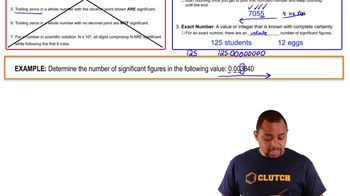Express the quantity 254,998 m in each unit. a. km b. Mm c. mm d. cm
Ch.1 - Matter, Measurement & Problem Solving
Chapter 1, Problem 9
Calculate the density of a liquid in g/mL to the correct number of significant digits, if a flask containing 9.55 mL of the liquid weighs 157.2 g with the liquid and 148.4 g when empty.
 Verified step by step guidance
Verified step by step guidance1
Calculate the mass of the liquid by subtracting the mass of the empty flask from the mass of the flask with the liquid: \( m_{\text{liquid}} = m_{\text{flask with liquid}} - m_{\text{empty flask}} \).
Substitute the given values into the equation: \( m_{\text{liquid}} = 157.2\, \text{g} - 148.4\, \text{g} \).
Determine the volume of the liquid, which is given as 9.55 mL.
Use the formula for density: \( \text{Density} = \frac{\text{mass}}{\text{volume}} \).
Substitute the mass of the liquid and the volume into the density formula to find the density in g/mL, ensuring the answer is reported with the correct number of significant figures.
Key Concepts
Here are the essential concepts you must grasp in order to answer the question correctly.
Density
Density is defined as the mass of a substance divided by its volume, typically expressed in grams per milliliter (g/mL) for liquids. It is a crucial physical property that helps identify substances and can indicate purity. The formula for density is D = m/V, where D is density, m is mass, and V is volume.
Recommended video:
Guided course

Density Concepts
Significant Figures
Significant figures are the digits in a number that contribute to its precision. This includes all non-zero digits, any zeros between significant digits, and trailing zeros in the decimal portion. When performing calculations, the result should be reported with the same number of significant figures as the measurement with the least number of significant figures to maintain accuracy.
Recommended video:
Guided course

Significant Figures Example
Mass Calculation
To find the mass of the liquid in the flask, subtract the mass of the empty flask from the total mass of the flask with the liquid. This calculation is essential for determining the mass component needed to calculate density. In this case, the mass of the liquid is 157.2 g (total) - 148.4 g (empty) = 8.8 g.
Recommended video:
Guided course

Molar Mass Calculation Example
Related Practice
Textbook Question
2
views
Textbook Question
Classify each statement as an observation, a law, or a theory.
a. All matter is made of tiny, indestructible particles called atoms.
b. When iron rusts in a closed container, the mass of the container and its contents does not change.
c. In chemical reactions, matter is neither created nor destroyed.
d. When a match burns, heat is released
34
views
1
rank
Textbook Question
Classify each statement as an observation, a law, or a theory. a. Chlorine is a highly reactive gas. b. If elements are listed in order of increasing mass of their atoms, their chemical reactivities follow a repeating pattern. c. Neon is an inert (or nonreactive) gas. d. The reactivity of elements depends on the arrangement of their electrons.
32
views
1
rank
